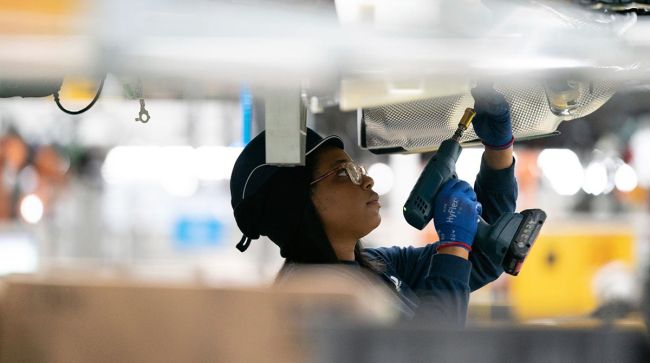An employee works on a car on the assembly line at the BMW Spartanburg plant in Greer, S.C. (Sean Rayford, AP)
WASHINGTON — U.S. employers added 187,000 jobs in July, fewer than expected, as the higher interest rates continued to weigh on the economy. But the unemployment rate dipped to 3.5% in a sign that the job market remains resilient.
Hiring was up from 185,000 in June, a figure that the Labor Department revised down from an originally reported 209,000. Economists had expected to see 200,000 new jobs in July.
Trucking lost 2,900 seasonally adjusted jobs in the period.
Still last month’s hiring was solid, considering that the Federal Reserve has raised its benchmark interest 11 times since March 2022. And the Fed’s inflation fighters will welcome news that more Americans entered the job market last month, easing pressure on employers to raise wages to attract and keep staff.
“This is a good strong report,” said Julia Pollak, chief economist at the jobs website ZipRecruiter. ”The worst fears that people had of a painful downturn, a loss of jobs, longer unemployment durations, all those things — those are not coming to pass.”
The U.S. economy and job market have repeatedly defied predictions of an impending recession. Increasingly, economists are expressing confidence that inflation fighters at the Federal Reserve can pull off a rare “soft landing’’ — raising interest rates just enough to rein in rising prices without tipping the world’s largest economy into recession. Consumers are feeling sunnier too: The Conference Board, a business research group, said that its consumer confidence index last month hit the highest level in two years.
Payroll employment rises by 187,000 in July; unemployment rate changes little at 3.5% https://t.co/ZwrVfLviqL #JobsReport #BLSdata
— BLS-Labor Statistics (@BLS_gov) August 4, 2023
There’s other evidence the job market, while still healthy, is losing momentum. The Labor Department reported Aug. 1 that job openings fell below 9.6 million in June, lowest in more than two years. But, again, the numbers remain unusually robust: Monthly job openings never topped 8 million before 2021. The number of people quitting their jobs – a sign of confidence they can find something better elsewhere – also fell in July but remains above pre-pandemic levels.
The Fed wants to see hiring cool off. Strong demand for workers pushes up wages and can force companies to raise prices to make up for the higher costs.






